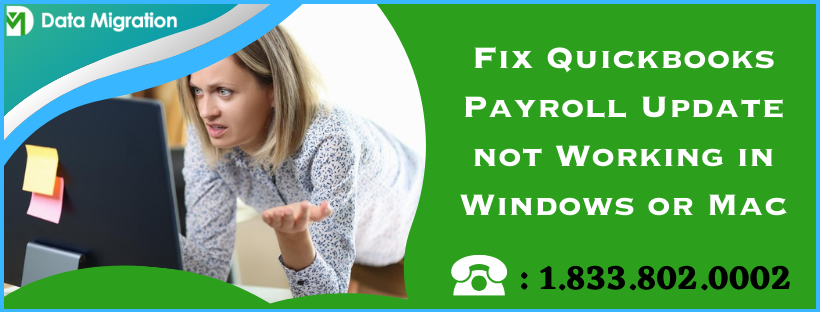Are you experiencing the QuickBooks payroll update not working issue when downloading recent payroll updates? If so, continue reading this article to learn about practical solutions to fix this issue.
Payroll is an essential feature in QuickBooks that helps users perform various crucial tasks, like processing payroll, direct deposit, tax calculations, etc. However, this QB feature needs to be updated regularly to ensure seamlessness and efficiency. Unfortunately, sometimes, you might not be able to download the latest QB payroll updates due to errors and glitches.
The payroll update issue usually arises due to an outdated QuickBooks or an unverified digital signature certificate. If QuickBooks is not updating payroll, you need to resolve the issue as soon as possible. To help you fix this issue, we have provided a detailed guide below with the main reasons and effective solutions. So, let’s read further and resolve the payroll update issues effortlessly.
Effective Solutions to Fix QuickBooks Desktop Payroll Not Updating Issue (Updated)
The ‘QuickBooks payroll updates not working’ issue can prevent users from updating the QB Payroll tax table. Thus, this issue needs to be fixed; otherwise, users will be unable to avail of the latest payroll features. Once you have understood the reasons behind this issue, follow the troubleshooting solutions given below to resolve them effortlessly-
Solution 1 – Download QB Desktop Updates as an Admin
You need to ensure that your QuickBooks is properly updated before running the payroll updates. For this, download the latest software updates with admin rights as follows –
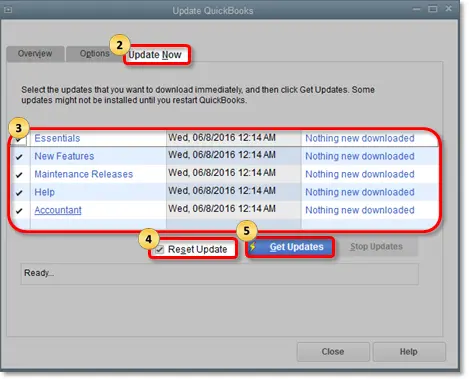
- Close the company files, exit QBDT, and right-click the QB Desktop icon.
- Next, select Run as Admin and click Yes when the “Do you want to allow this program to make changes to your computer?” message appears on the screen.
- Now, go to the Help tab, choose Update QuickBooks Desktop, and then click Update Now.
- Lastly, mark the Reset Updates checkbox, click Get Updates, and reopen QuickBooks to install the updates by hitting Install Now.
Once the QB updates are installed, download the latest payroll tax table updates by following the steps below.
Download Payroll Tax Table Updates in QB
- Open the Employees menu in QBDT, select Get Payroll Updates, and click Download Entire Update.
- Now, select Update, and once the process ends, an informational window will appear, indicating that your download is complete.
If you encounter issues downloading the payroll updates even after updating the software, move to the next solution to fix them.
Solution 2 – Install the QB Digital Signature Certificate
An unverified or expired digital signature certificate can prevent users from downloading the latest payroll updates. To resolve this issue, install a fresh digital signature certificate by implementing the detailed steps given below –
- Open the C Drive of your PC, select Program Files, and click the Intuit folder.
- Next, choose the QuickBooks folder, then locate and right-click the QBW32.exe file.
- Properties, then click Digital Signature and ensure that Intuit is selected in the signature list.
- Further, select Details, go to the Digital Signature Details window, and click View Certificate.
- Now, open the Certificate window, select Install Certificate, then click Next.
- Select Next until Finish is displayed, then hit Finish and restart your PC.
Once done, reopen QuickBooks and try to download the payroll updates again. If QuickBooks Desktop payroll won’t update yet, move to the next solution and repair QB.
Solution 3 – Repair QuickBooks Desktop with QuickBooks Tool Hub
Problems while installing QuickBooks or while running the program can be another reason behind the update issues in QB Payroll. Address this issue by repairing the application with the QB Tool Hub utilities in the following manner –
Step 1 – Download QB Tool Hub
QuickBooks Tool Hub is a troubleshooting utility containing a collection of tools that help easily diagnose and resolve common QB errors. To download this utility and access its tools, follow the detailed steps given below –
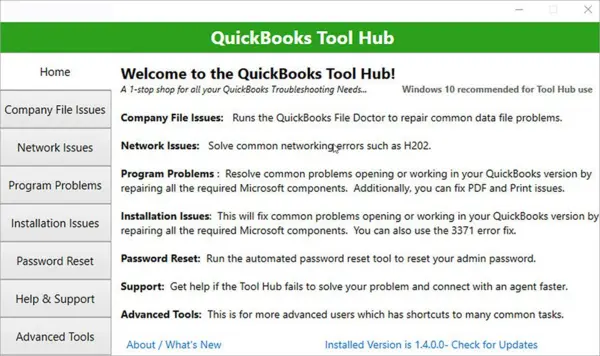
- Exit QuickBooks, download the most recent QuickBooks Tool Hub version from Intuit, and save the file in an accessible location on your PC.
Note: If you have installed the QB Tool Hub before, you can find out its current version at the bottom of the Home tab. - Open the QuickBooksToolHub.exe setup file you downloaded, then follow the on-screen prompts to install the program and agree to the terms and conditions.
- When the installation process finishes, double-click the QB Tool Hub icon on your Windows desktop to access the program. However, if you can’t find the icon, manually search for “QuickBooks Tool Hub” in your Windows search bar and access the program.
Once the QB Tool Hub is installed, move to the next step and use the Quick Fix My Program tool.
Step 2 – Run the Quick Fix My Program Utility
This tool helps shut down any background processes used by QuickBooks and can address general program issues. You can use the tool to fix the program problems in the following manner –

- Firstly, launch the QuickBooks Tool Hub, then go to the Program Problems section and select the Quick Fix My Program tool.
- Once the tool stops running, relaunch QuickBooks Desktop and access your data file.
Now, check if the program problems are resolved and if you can run the payroll update process. If the update issues persist, move to the next section and run the QB Install Diagnostic tool.
Step 3 – Utilize the QB Install Diagnostic Utility
If the Quick Fix My Program tool is unable to address the payroll update issues, try fixing the installation problems. Issues during the QuickBooks installation process can be resolved by running the QuickBooks Install Diagnostic tool in the following way –
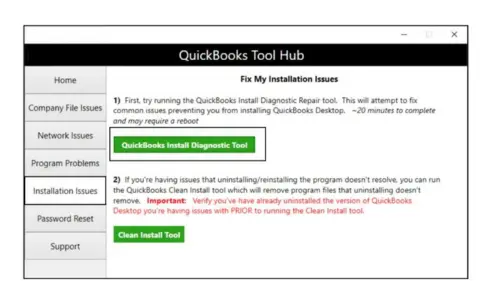
- Launch QuickBooks Tool Hub, move to the Installation Issues menu and select the QuickBooks Install Diagnostic tool.
- Let the tool run, which can take up to 20 minutes, and once the process ends, restart your PC.
- Restart QuickBooks Desktop, then open your data file and update the app and QB payroll to the latest release (see solution 1).
Once QuickBooks is repaired, check if the “QuickBooks Desktop payroll isn’t updating” issue is resolved. If not, reinstall QuickBooks in the next solution.
Solution 4 – Reinstall QBDT
If repairing QuickBooks doesn’t help with the payroll update issues, reinstall it. Installing a new QB version in the following manner can ensure that any general issues in the current version are fixed, which can help address the payroll update problems –
Prerequisites –
Before reinstalling, download the installer for your QB Desktop version. Also, ensure that you have your license number handy so that the installation process goes seamlessly.
Once done, follow the detailed steps below to reinstall QB Desktop successfully.
Step 1 – Remove/Uninstall QuickBooks
The first step is to uninstall QuickBooks Desktop from your PC. Undertake the QB uninstallation process by following the steps given below –
- Access the Windows Start menu, search for “Control Panel” in the search bar, and open it.
- Select Programs and Features or Uninstall a Program, then from the program list, select the QB version you want to uninstall.
- Select Uninstall/Change, Remove, and hit Next to complete the process.
Note: If you don’t see the “uninstall/change, remove” option, sign back into Windows with admin privileges and then undertake the removal process.
Once QB is successfully removed from the system, reinstall the software in the next section.
Step 2 – Reinstall QuickBooks
The next step is to install QuickBooks Desktop again. Remember, the software will automatically install new folders and rename the old ones during the installation process. To reinstall QB, first, make sure that the system requirements are met, then go through the steps below –
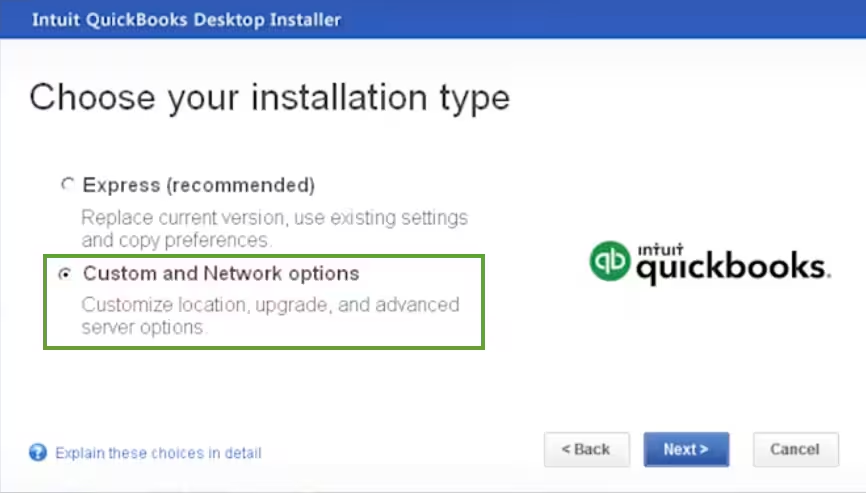
- Firstly, download your QuickBooks Desktop version, then save the file at an accessible location on your PC and open the downloaded .exe setup file.
- Further, go through the on-screen prompts, accept the software license agreement, and then click Next.
- Enter the product and license numbers, choose Next, and then make sure you have an active internet connection to install the QB Desktop software.
- Choose Express as the Installation Type, then hit Next, and click Install.
- When the installation process ends, select Open QuickBooks, then proceed with the activation process.
After you have installed the app, you need to activate it. To do the same, follow the steps in the next section.
Step 3 – Activate QB Desktop
Once QB is installed in the system, activate the software manually by going through the steps given below –
- Launch QuickBooks, then access the Help menu and click Activate QuickBooks Desktop.
- Now, follow the steps on the screen to verify your info, and once the product is activated, launch it.
Once QuickBooks is successfully reinstalled, rerun QuickBooks and download the payroll updates again. If the updates are still not working, move to the next troubleshooting solution.
Solution 5 – Run the Verify/Rebuild Data Utility
Sometimes, payroll update issues in QB can arise due to damaged or corrupted company files. To resolve the data integrity issues, run the Verify/Rebuild Data utility in the following manner –
Step 1 – Verify your QB Company Data
Firstly, you need to verify the company data and identify the issues by running the Verify Data tool in the following manner –
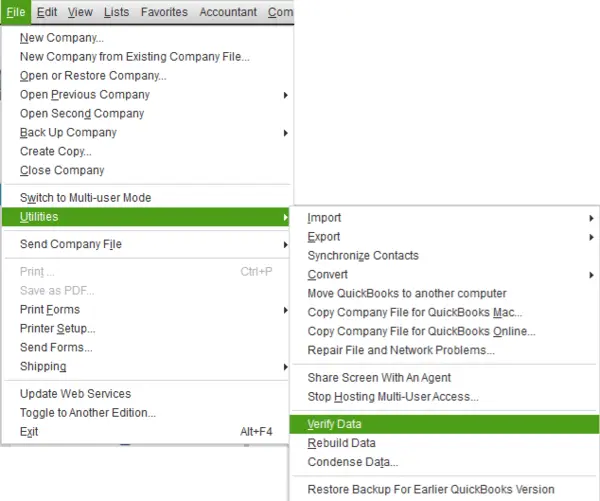
- Firstly, go to the Window, then select Close All and open the QuickBooks File menu.
- Further, select Utilities and click Verify Data, then take the following actions based on the results after running the tool –
- If QuickBooks detects no problems with your data, it is clean and confirms its integrity. Hence, you don’t need to proceed with further steps.
- On the other hand, if an error message appears, search for it on our QuickBooks Desktop support site to find out how to resolve the error.
- If you get the “company data has lost integrity” message, there is data damage in the file, and you need to rebuild your data to fix it.
Once the verification process is complete, move to the next section and run the Rebuild Data tool to resolve the identified issues.
Step 2 – Rebuild Your QB Company File Data
You can utilize the Rebuild Data utility to address the issues with your company file by following the steps given below –
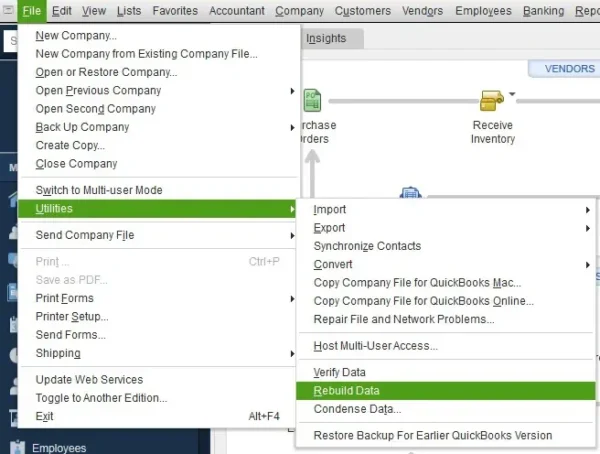
- Open QuickBooks and access the File tab, then select Utilities and click Rebuild Data.
- Now, QuickBooks will ask to create a backup before running the tool. Select OK, create the backup, select a location to save the backup file, and then hit OK again. Remember not to replace another backup file. Enter a new name in the File name field, then hit Save.
- Select OK when the Rebuild has completed message appears, then go back to the File tab.
- Select Utilities, then click Verify Data again to check for additional data damage and undertake the following actions –
- If the tool finds more damage, you’ll need to manually resolve the identified issues. To do this, search for the error(s) in the qbwin.log on the QuickBooks Desktop Support Site and learn ways to resolve the errors effectively.
- If no errors are found, restore the recent company file backup by selecting Open or Restore Company from the File tab.
Note: Don’t replace your existing QB company file. You’ll need to re-enter information since the file backup was created.
Solution 6 – Reset the Internet Explorer Settings
Incorrect Internet Explorer settings or changes in the setup can interfere with the QB payroll update process. You need to restore the IE settings and rerun the payroll update process to get rid of the QuickBooks payroll not updating issue.
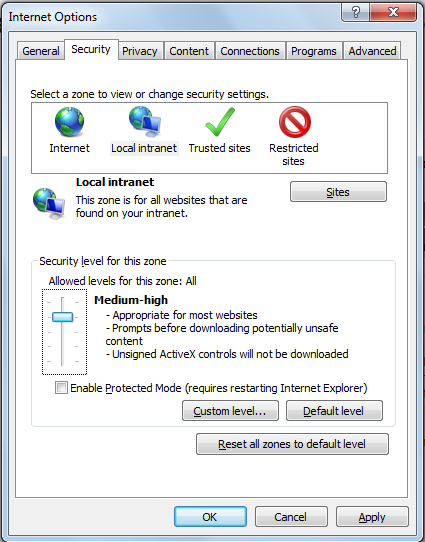
- Exit QuickBooks and open IE, then select the Tools icon from the top-right corner.
- Select Internet Options from the drop-down menu, then select the Advanced tab and hit the Reset or Restore Defaults option.
- Hit Apply and OK, then relaunch QuickBooks and proceed with the payroll update process.
If you are still unable to download the payroll updates, move to the next solution to fix the issues.
Solution 7 – Configure Windows Firewall and the Antivirus Program
Blockages imposed by the misconfigured Windows firewall or an antivirus program can interfere with the payroll updates in QB. To get rid of these blockages, you need to configure the firewall and the antivirus program in the following manner –
Step 1 – Run the QB File Doctor Utility
This tool can be used to fix network problems by configuring the Windows firewall automatically. To run the tool swiftly, ensure that the QB Tool Hub is installed (see step 1 of solution 3 above), then follow the detailed instructions below.
- Firstly, launch the QuickBooks Tool Hub, select the Company File Issues menu, then select the QuickBooks File Doctor tool.
Note: It may take up to a minute for the tool to open; however, if the tool isn’t accessible, manually open it by searching for “QuickBooks Desktop File Doc” in the Windows search bar. - In the QuickBooks File Doctor utility, pick the company files you want to repair from the dropdown menu. If you can’t locate the file, select Browse and Search to locate the QB company file, then select it.
- Further, click Check your file and network, hit Continue, then enter your admin credentials.
- Select Next and wait for the scan process to end, then open QuickBooks Desktop and access the company file.
Note: The file scan usually takes up to 5 minutes, depending on your file size. Remember that sometimes the scan may say it was unsuccessful, even if it fixes the company file and network issues.
Rerun QB and download the payroll updates to check if the update issues have been removed. If you are still unable to update payroll, move to the next step and configure the Windows firewall manually.
Step 2 – Configure Windows Firewall Manually
If using the QB File Doctor tool doesn’t resolve the network and firewall issues, you need to manually configure the Windows firewall. Follow the steps given below to create firewall exceptions for QuickBooks –
Create Firewall Port Exceptions for QuickBooks
To allow QuickBooks to access the internet without firewall blockages, create firewall port exceptions by using the steps given below –
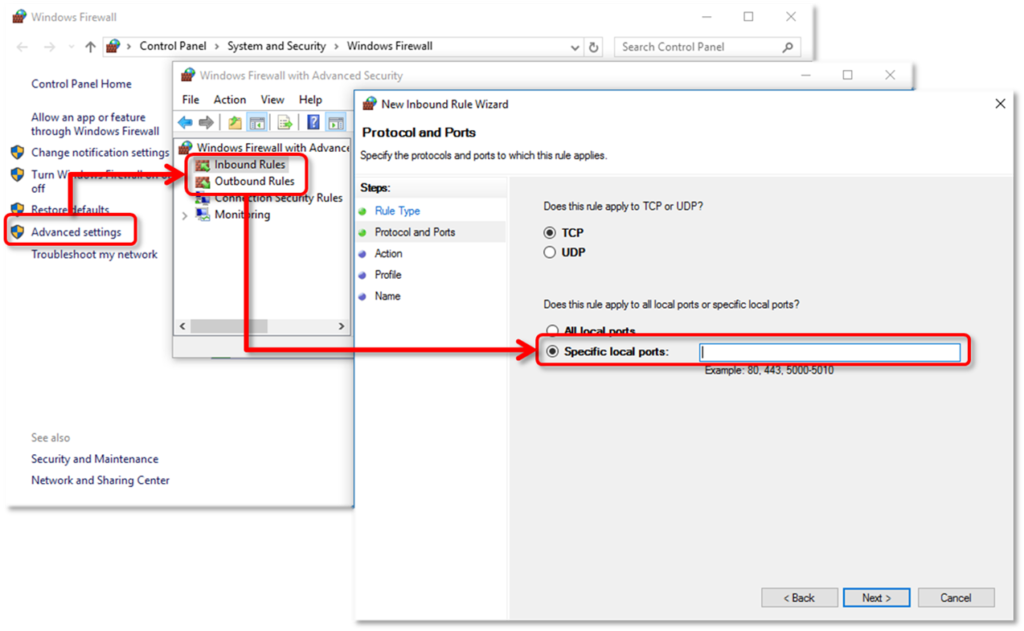
Note: If you use multiple QB Desktop versions on the same PC, follow these steps to configure the Windows firewall for each version. Moreover, in step 4 below, you need to include each year’s (version’s) ports in the Specific Local Ports field.
- Open the Start menu and type “Windows Firewall” in the Windows search bar, then access the program.
- Now, open the Advanced Settings tab, then right-click Inbound Rules and choose New Rule.
- Select Port and hit Next, then make sure that the TCP option is checkmarked.
- Further, refer to the list provided below to enter the specific ports (as per your QBDT version) in the Specific Local Ports field –
- QuickBooks Desktop 2020 and later: 8019, XXXXX.
- QuickBooks Desktop 2019: 8019, XXXXX.
- QuickBooks Desktop 2018: 8019, 56728, 55378-55382.
- QuickBooks Desktop 2017: 8019, 56727, 55373-55377.
Important: QuickBooks Desktop 2019 and future versions use dynamic ports that are specifically assigned during installation. This provides QB exclusive use of a particular port; thus, if you use any of these versions, include their dynamic port number in the following manner –
- To get the Dynamic Port Number according to your QBDT version, implement the steps below –
- Open the Windows Start menu, then enter “QuickBooks Database Server Manager” in the search panel and access the tool.
- Further, move to the Port Monitor tab, find your QuickBooks version, and make a note of the Port Number to include in the port exceptions list.
Note: If you are using QBDT 2019 and future versions, edit the assigned port number by choosing Renew. If you renew the port number, select Scan Now from the Scan Folders tab and reset the Windows firewall permissions.
- Add the port number in the port exceptions list, select Next hit Allow the Connection, then click Next again.
- Next, make sure all profiles are checkmarked (if asked), then select Next and create a new rule named “QBPorts(year).”
- Once done, click Finish, and your QB port exception rule will be created.
- Lastly, implement the same steps above (see steps 1 to 8) to create Outbound Rules for QB. While making the rules, ensure that you choose Outbound Rules instead of Inbound Rules in Step 2.
Once the exception rules are created, access the software in a multi-user environment or over the network from the host PC. Then, check if you can run the payroll updates without issues. If you are still experiencing the QuickBooks not updating payroll issue, create firewall exceptions for QuickBooks executable (.exe) files in the next section.
Add Firewall Exceptions for Executable Files in QB
Executable files (.exe) are used by QBDT to perform various functions. You need to create exceptions for these executable files and remove firewall blockages by going through the following steps –
- Search for “Windows Firewall” in the Windows search bar, then open the utility and choose the Advanced Settings tab.
- Further, right-click Inbound Rules, then select New Rule and hit Program.
- Click Next, select This Program Path, then click Browse and pick an executable file from the table below –
| Executable files | Location |
| AutoBackupExe.exe | C:\Program Files\Intuit\QUICKBOOKS YEAR |
| Dbmlsync.exe | C:\Program Files\Intuit\QUICKBOOKS YEAR |
| DBManagerExe.exe | C:\Program Files\Intuit\QUICKBOOKS YEAR |
| FileManagement.exe | C:\Program Files\Intuit\QUICKBOOKS YEAR |
| FileMovementExe.exe | C:\Program Files\Intuit\QUICKBOOKS YEAR |
| QuickBooksMessaging.exe | C:\Program Files\Intuit\QUICKBOOKS YEAR |
| QBW32.exe | C:\Program Files\Intuit\QUICKBOOKS YEAR |
| QBDBMgrN.exe | C:\Program Files\Intuit\QUICKBOOKS YEAR |
| QBServerUtilityMgr.exe | C:\Program Files\Common Files\Intuit\QuickBooks |
| QBCFMonitorService.exe | C:\Program Files\Common Files\Intuit\QuickBooks |
| QBLaunch.exe | C:\Program Files\Common Files\Intuit\QuickBooks |
| QBUpdate.exe | C:\Program Files\Common Files\Intuit\QuickBooks\QBUpdate |
| IntuitSyncManager.exe | C:\Program Files\Common Files\Intuit\Sync |
| OnlineBackup.exe | C:\Program Files\QuickBooks Online Backup |
- Hit Next, select Allow the Connection, then hit Next again and ensure that all the profiles are marked (if required).
- Further, select Next, then save the file exception rule as “QBFirewallException(name.exe).”
- Lastly, use the same steps above (see steps 1 to 5) to create Outbound Rules for the executable files. While creating these rules, choose Outbound Rules instead of Inbound Rules in step 2, then rerun QuickBooks in a multi-user mode.
Now, check the status of the payroll update issues in QB. If the issues still appear, review the antivirus software settings in the next section.
Step 3 – Review the Antivirus Settings
If you configured your Windows firewall but are still facing issues while updating QB payroll, configure your antivirus settings. This step will ensure that QuickBooks has proper permissions and is running without any interference from the antivirus software. The troubleshooting steps depend on your antivirus software; thus, you need to undertake the specific steps for your particular antivirus program to review the settings. To reconfigure the settings for QB, visit the official website of the antivirus you are currently using or contact your vendor.
Once the antivirus software is configured to allow QuickBooks without restrictions, launch the software and download the payroll updates again. Check the status of the QuickBooks Enterprise 22 payroll update not syncing issue; however, if it persists, move to the next solution.
Solution 8 – Enable QuickBooks File Copy Service
If your QuickBooks FCS is not running correctly or is inactive, QuickBooks won’t be able to initiate and execute the update process. Thus, ensure that the QuickBooks FCS is enabled before running the payroll updates by following the steps below –
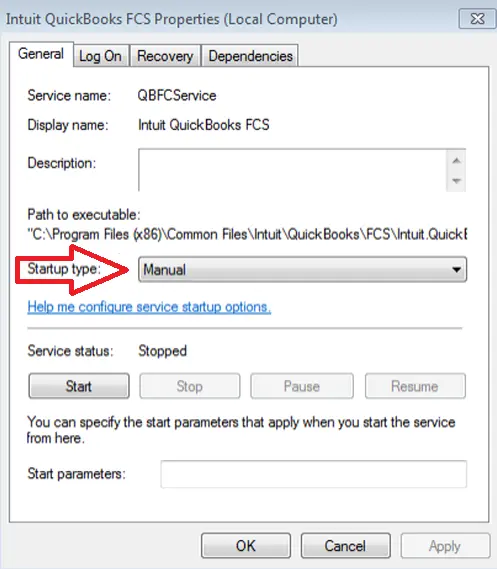
Step 1 – Start QuickBooks FCS Manually
Intuit QuickBooks File Copy Service can be manually enabled by implementing these steps –
- Firstly, press the Windows + R keys on your keyboard to access the Run window, then type COMPMGMT.MSC in the Run command box.
- Hit OK, then move to the Computer Management Window and click Services and Applications.
- Further, select Services and scroll the cursor down to locate Intuit QuickBooks FCS, then double-click the service.
- Click on Startup type and select the Manual option, then hit Apply and OK to enable the FCS.
Once the service is enabled, revalidate the payroll service key to refresh the connection in the next section.
Step 2 – Validate the QB Payroll Service Key Again
You can revalidate the payroll service key in QuickBooks Desktop by following the steps below –
- Launch QuickBooks, open the Employees menu, then choose My Payroll Service.
- Click Activate Service Key, then highlight the current payroll in the Service Keys window.
- Select Edit, and hit Next until Finish comes up, then hit Finish to end the process.
Once the service key is revalidated, open QuickBooks and download the payroll updates. However, if the payroll updates are still not working, move to the next solution and check the date/time settings on the PC.
Solution 9 – Ensure that the Date/Time Settings are Correctly Set
If your system’s date and time settings are incorrectly set, it can cause problems while updating QB payroll. To address this payroll update issue, verify the date/time settings in the following manner –
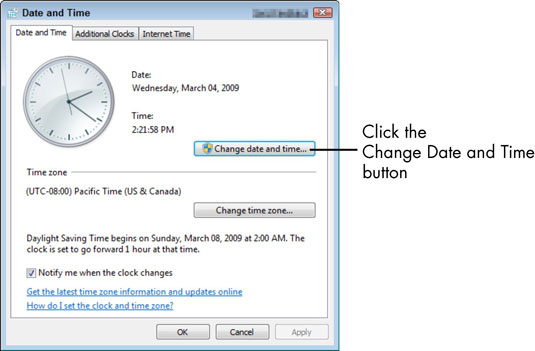
- Right-click on the bottom right corner of the screen and select Adjust Date/Time, then hit the Change Date and Time option from the drop-down menu.
- Set the correct date and time, then hit OK to save the changes and reopen QuickBooks.
Now, download the payroll updates again, but if the issues persist, move to the next solution and rename the CPS folder.
Solution 10 – Rename the CPS Folder
A damaged file in the CPS folder or a corrupted folder can be a major reason behind payroll update issues in QB. To tackle the issue, you need to rename the CPS folder in the following manner –
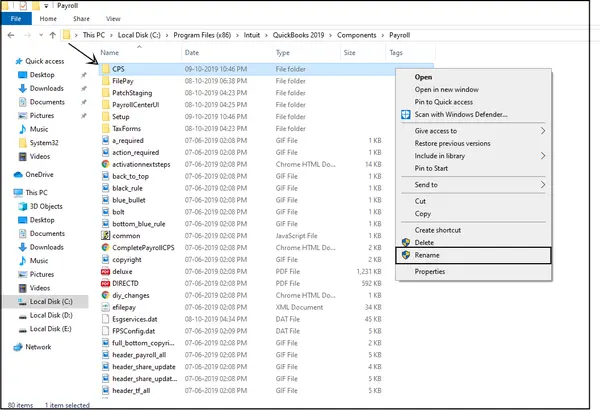
- Press the Windows+ E keys to open Windows File Explorer, then click on This PC.
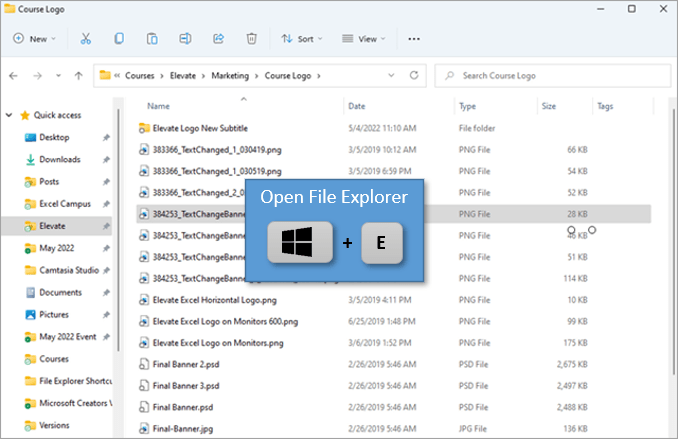
- Now, navigate to the Local Disk C, run Program Files (x86), then choose the Intuit folder.
- Access your QuickBooks Desktop folder that matches the current QB version, then click on Components and select the Payroll folder.
- Right-click the CPS folder, choose Rename, then enter a new folder name and press Enter to successfully rename it.
Once done, rerun QuickBooks and download the latest payroll updates again. Check the status of the “payroll services will not update through Quickbooks” issue and ensure that it is fixed.
Major Reasons Why QuickBooks Payroll Will Not Update (Updated)
There can be many reasons why you are unable to download payroll updates in QuickBooks. Therefore, it is essential to understand these reasons to undertake the resolution process with better clarity. In this section, we have compiled all the causes that disrupt the payroll update process and trigger update issues in QuickBooks. Go through each one of them meticulously.
- Your QuickBooks Desktop is not updated to the latest release, which can cause compatibility problems while downloading payroll updates.
- You are not running the update process with admin privileges, which can lead to access issues.
- The digital signature certificate might be unverified, expired, or invalid, which can prevent users from downloading payroll updates.
- Your QuickBooks program might be damaged, or the installation process might be faulty or incomplete.
- Essential files and data in QuickBooks might be damaged, corrupted, or face integrity issues.
- Your system’s date and time settings might be incorrectly set, causing issues with the payroll update process.
- The Internet connection settings might be incorrectly configured while downloading updates.
- The Windows firewall or an anti-virus app might be set to create blockages in QuickBooks.
- Files and components essential for running the payroll updates might be missing from the PC.
- The CPS folder in QuickBooks might be damaged, or the data/files in the folder might be corrupted.
- QuickBooks File Copy Service might be inactive or disabled, which can be another trigger for payroll update issues.
These are the leading reasons why you are unable to download QB payroll updates. Let’s move on to the next section to find practical solutions to fix this issue.
Conclusion
We hope this comprehensive guide helped you resolve the QuickBooks payroll update not working issue effectively.
FAQ’s
Why should I update the payroll function in QuickBooks Desktop?
QB users need to update the payroll function regularly to install updates and releases. These QB payroll updates include the most current and accurate rates and calculations for state and federal tax tables, payroll tax forms, e-file, and pay options. Thus, downloading these payroll updates can provide access to the latest features, leading to a seamless experience.
What is the “QuickBooks payroll won’t update” issue?
The QuickBooks Desktop payroll updates not working issue is a common issue that can arise while downloading recent payroll updates. This issue can interfere with the update process and prevent users from downloading the latest payroll features. An outdated QB or an unverified subscription, among other possible reasons, can be behind this issue.
Do I need to take a company file backup before resolving the payroll update issues?
Yes, backing up your company file before running the troubleshooting process can help eliminate the risk of data loss. Hence, before fixing the payroll update issues, you need to create a backup version for the company file.
What information is required to check the payroll account when QB Payroll won’t update?
You will require the following details to check the payroll account when facing the QuickBooks not taking payroll updates issue –
Physical address and date of birth of the Principal Officer.
Social Security Number (SSN) of the Principal Officer.
Type of industry, along with business type.
Address of the physical business.
You May Also Like To Read-
An Easy Guide to Fix QuickBooks Time Error Code 10000
A Quick & Simple Guide To Troubleshoot QuickBooks Error 15243
A step-by-step easy Guide to fix QuickBooks Error H505
QuickBooks Error 6175 – Quick & Easy Troubleshooting Methods
QuickBooks Error 6175 – Quick & Easy Troubleshooting Methods

James Richard is a skilled technical writer with 16 years of experience at QDM. His expertise covers data migration, conversion, and desktop errors for QuickBooks. He excels at explaining complex technical topics clearly and simply for readers. Through engaging, informative blog posts, James makes even the most challenging QuickBooks issues feel manageable. With his passion for writing and deep knowledge, he is a trusted resource for anyone seeking clarity on accounting software problems.
